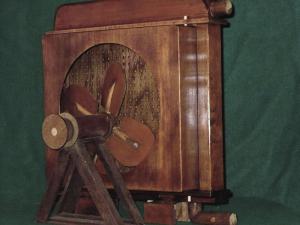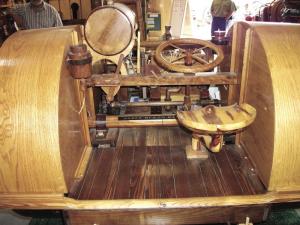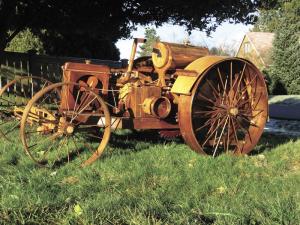Rare Tractor Recreated In Wood
Carving a tractor out of wood is a piece of cake compared to what Mike Pray did. He recreated individual components and then bolted them together with wooden nuts and bolts. With the exception of the engine, everything moves as it did in the original Huber tractor he patterned it after.
"I thought about making a working engine with pistons, rings and valves, but thought that might be taking the project too far," laughs Pray, who doesn't consider himself a woodworker. "I just enjoy projects once I get started."
When Pray turns the crank on the tractor, the fan, flywheel, drive shaft, gears and rear wheels all turn. When he turns the steering wheel, the front wheels respond. Even the dipstick can be removed with its oil stained tip.
Pray spent more than 2,000 hrs. designing and building the half scale Huber Light Four. He used 21 different types of wood, including antique heart pine from a factory that burned in 1890. Other exotic and domestic woods came from waste pieces his son and daughter brought home from a custom door factory where they worked.
Pray had seen a picture of the Huber, which was introduced in Ohio in 1916, on the Huber Museum website. With the help of readers of Antique Power Magazine, he got pictures and information to go by.
Clyde Austin, a machinist friend, made patterns for the 16-in. and 27-in. gears on the main driveshaft. Pray cut gear teeth out of Philippine mahogany with a scroll saw (72 teeth in the 16-in. gear alone). He figures the gears took 30 hrs. each to rough out and finish.
Making the rear wheels with spokes and outer rim took 40 hrs. with another 60 for the front wheels. He used 1/8-in. Luan plywood panel door skins to make the outer rims for the 4-in. wide front wheels and 6-in. wide rears. Pray used a steam iron to gently shape the four-layer laminate.
Getting the working steering mechanism was its own challenge. The steering wheel connects to the front wheels with dowel shafts, three universal gears, a worm gear in a gearbox and an arm to the tie rods. The worm gear alone used four different kinds of wood, including maple for the steering arm, black walnut for the gearbox, purple heart for the round gear and hard rock maple for the worm gear.
"Doing the worm gear for the steering mechanism was really involved," recalls Pray. "Clyde suggested using two strips of masking tape to make the spiral and making a jig to hold it as I worked. I used a 1/8-in. router bit to get the depth of my cut, following the centerline between the pieces of tape. I then had to make 15 passes with a special router bit to get the right pitch and depth of the worm gear."
The gas tank was fabricated from 3/4-in. strips of 1/4-in. thick red cedar. The strips were cut, shaped, butted edge-to-edge and glued to the round ends to make the tank. Once complete, they were sanded and buffed to match the smooth finish of the rest of the tractor.
While Pray didn't make a complete moving engine, he did make it as lifelike as possible with cylinder heads, spark plugs and magneto. Wires were fashioned from weeping willow branches. The oil pan is western red cedar, and the head bolts are walnut.
The only parts on the tractor not made from wood are the leather belt on the fan pulleys and the throttle spring, which was fabricated from box string wrapped around a pencil and saturated with glue. Dried and removed, it mimics a wire spring perfectly.
Pray has collected numerous woodworking prizes for the tractor. He displays it on a small moveable stage that also serves as a base for the tractor's own storage box. For parades, he loads it on a 1/2-scale model, 1906 seat-over-engine Mack truck he also built. Should a piece break, as the worm gear once did, it can be replaced, thanks to the wooden bolts that hold it together.
"If I needed to, I could disassemble the entire thing," says Pray, who often displays it for visitors. "As long as it isn't raining, I'll pull it out."
Contact: FARM SHOW Followup, Mike Pray, 11510 26th St. N.E., Lake Stevens, Wash. 98258 (ph 425 334-4282; praymike@hotmail.com).

Click here to download page story appeared in.
Click here to read entire issue
Rare Tractor Recreated In Wood FARM HOME Novelty Items Carving a tractor out of wood is a piece of cake compared to what Mike Pray did He recreated individual components and then bolted them together with wooden nuts and bolts With the exception of the engine everything moves as it did in the original Huber tractor he patterned it after I thought about making a working engine with pistons rings and valves but thought that might be taking the project too far laughs Pray who doesn t consider himself a woodworker I just enjoy projects once I get started When Pray turns the crank on the tractor the fan flywheel drive shaft gears and rear wheels all turn When he turns the steering wheel the front wheels respond Even the dipstick can be removed with its oil stained tip Pray spent more than 2 000 hrs designing and building the half scale Huber Light Four He used 21 different types of wood including antique heart pine from a factory that burned in 1890 Other exotic and domestic woods came from waste pieces his son and daughter brought home from a custom door factory where they worked Pray had seen a picture of the Huber which was introduced in Ohio in 1916 on the Huber Museum website With the help of readers of Antique Power Magazine he got pictures and information to go by Clyde Austin a machinist friend made patterns for the 16-in and 27-in gears on the main driveshaft Pray cut gear teeth out of Philippine mahogany with a scroll saw 72 teeth in the 16-in gear alone He figures the gears took 30 hrs each to rough out and finish Making the rear wheels with spokes and outer rim took 40 hrs with another 60 for the front wheels He used 1/8-in Luan plywood panel door skins to make the outer rims for the 4-in wide front wheels and 6-in wide rears Pray used a steam iron to gently shape the four-layer laminate Getting the working steering mechanism was its own challenge The steering wheel connects to the front wheels with dowel shafts three universal gears a worm gear in a gearbox and an arm to the tie rods The worm gear alone used four different kinds of wood including maple for the steering arm black walnut for the gearbox purple heart for the round gear and hard rock maple for the worm gear Doing the worm gear for the steering mechanism was really involved recalls Pray Clyde suggested using two strips of masking tape to make the spiral and making a jig to hold it as I worked I used a 1/8-in router bit to get the depth of my cut following the centerline between the pieces of tape I then had to make 15 passes with a special router bit to get the right pitch and depth of the worm gear The gas tank was fabricated from 3/4-in strips of 1/4-in thick red cedar The strips were cut shaped butted edge-to-edge and glued to the round ends to make the tank Once complete they were sanded and buffed to match the smooth finish of the rest of the tractor While Pray didn t make a complete moving engine he did make it as lifelike as possible with cylinder heads spark plugs and magneto Wires were fashioned from weeping willow branches The oil pan is western red cedar and the head bolts are walnut The only parts on the tractor not made from wood are the leather belt on the fan pulleys and the throttle spring which was fabricated from box string wrapped around a pencil and saturated with glue Dried and removed it mimics a wire spring perfectly Pray has collected numerous woodworking prizes for the tractor He displays it on a small moveable stage that also serves as a base for the tractor s own storage box For parades he loads it on a 1/2-scale model 1906 seat-over-engine Mack truck he also built Should a piece break as the worm gear once did it can be replaced thanks to the wooden bolts that hold it together If I needed to I could disassemble the entire thing says Pray who often displays it for visitors As long as it isn t raining I ll pull it out Contact: FARM SHOW Followup Mike Pray 11510 26th St N E Lake Stevens Wash 98258 ph 425 334-4282; praymike@hotmail com









